Topics
- Page Path
-
- HOME
- TOPICS
- Topics
- Topics
-
- Adolescence Medicine (4)
- Allergy (61)
- Cardiology (79)
- Critical Care Medicine (10)
- Developmental and Behavioral Medicine (24)
- Emergency Medicine (5)
- Endocrinology (60)
- Gastroenterology (65)
- General Pediatrics (46)
- Genetics and Metabolism (24)
- Hematology (15)
- Immunology (15)
- Infection (73)
- Neonatology (Perinatology) (119)
- Nephrology (Genitourinary) (52)
- Neurology (94)
- Nutrition (30)
- Oncology (16)
- Neurobehavior (12)
- Pulmonology (30)
- Rheumatology (3)
- Other (36)
- Clinical note
- Immunology
- Salivary and lacrimal gland enlargement with serum immunoglobulin G4 elevation
- Jinseok Lee, Da-Eun Kim, Jeong-Hwan Yang, Misun Lim, Hye Yung Yum, JoongGon Kim
- Clin Exp Pediatr. 2021;64(2):93-95. Published online December 8, 2020
-
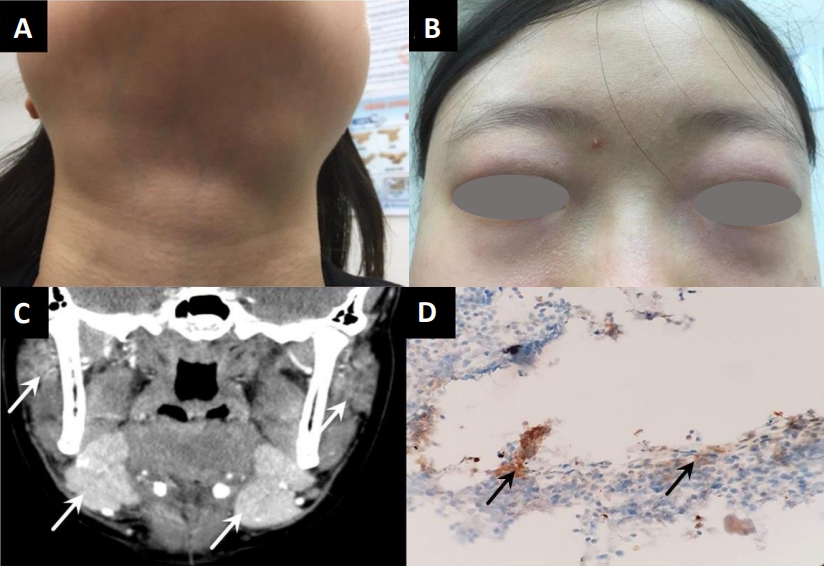
Question: What diseases should be considered in a 15-year-old girl presenting enlarged lacrimal and salivary glands?
Finding: Laboratory tests revealed elevated IgG4 levels. A submandibular gland biopsy showed lymphoplasmacytic infiltration and more than 40 immunoglobulin G4 (IgG4)-positive cells per high-power field. The patient was diagnosed with IgG4-related disease.
Meaning: Although rare in children, IgG4-related disease should be considered a differential diagnosis in children with enlarged salivary and lacrimal glands.
- Original Article
- Hematology
- Changes in the prevalence of anemia in Korean adolescents, 1998–2018
- Jun Young An, Yoo Rha Hong, Seom Gim Kong
- Clin Exp Pediatr. 2021;64(2):86-92. Published online November 16, 2020
-
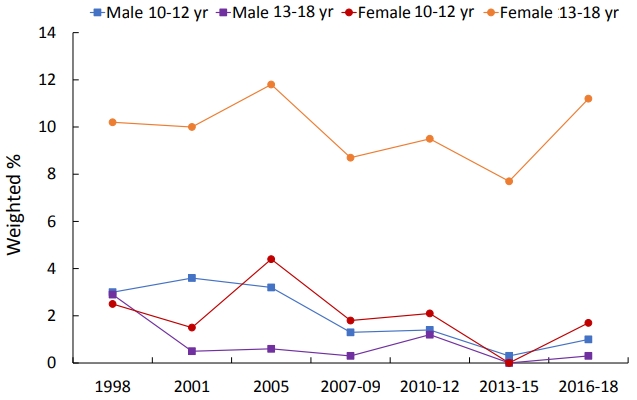
Question: Over the past 21 years, has the prevalence of anemia decreased among Korean adolescents?
Finding: The prevalence of anemia in boys aged 10–18 years decreased from 3.0% to 0.5% over the study period, whereas that in girls did not change significantly over time (increased from 7.9% to 8.5%).
Meaning: The prevalence of anemia in female adolescents remains high, requiring attention and efforts to improve it.
- Gastroenterology
- Value of the International Classification of Diseases code for identifying children with biliary atresia
- Pornthep Tanpowpong, Chatmanee Lertudomphonwanit, Pornpimon Phuapradit, Suporn Treepongkaruna
- Clin Exp Pediatr. 2021;64(2):80-85. Published online August 24, 2020
-

Question: What is the value of the diagnostic code in identifying cases of biliary atresia in a large administrative database?
Finding: The diagnostic code’s accuracy and sensitivity are acceptable for identifying algorithm-defined cases. A history of pale stool and a presumed diagnosis of biliary atresia prior to referral added value.
Meaning: The addition of clinical data to the diagnostic code significantly increased the diagnostic yield.
- Editorial
- Hematology
- Time to pay attention to anemia in female adolescents
- Jae Min Lee
- Clin Exp Pediatr. 2021;64(2):78-79. Published online February 1, 2021
-

- Cardiology
- Where should we start to improve pediatric heart transplantation outcomes?
- Jinyoung Song
- Clin Exp Pediatr. 2021;64(2):76-77. Published online November 25, 2020
-
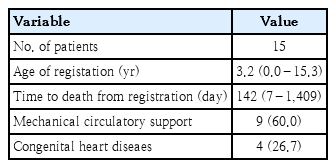
· Pediatric heart transplantation is achieving better outcomes.
· The waitlist mortality is still high, especially in Korea, and should be reduced.
· The use of ventricular assist device is promising and might offer improved waitlist mortality rates.
- Review Article
- General Pediatrics
- Clinical features, diagnosis, and outcomes of multisystem inflammatory syndrome in children associated with coronavirus disease 2019
- Ji Hee Kwak, Soo-Young Lee, Jong-Woon Choi; the Korean Society of Kawasaki Disease
- Clin Exp Pediatr. 2021;64(2):68-75. Published online December 30, 2020
-

Hundreds of cases of children and adolescents with hyperinflammatory responses such as Kawasaki disease have been reported amid the coronavirus disease 2019 (COVID-19) pandemic, leading to coining of the new term COVID-19–associated multisystem inflammatory syndrome in children. In this review article, we introduce the illness and describe its case definitions, epidemiology, pathogenesis, clinical features, treatments, and outcomes.
- Allergy
- Eosinophils and childhood asthma
- Bong Seok Choi
- Clin Exp Pediatr. 2021;64(2):60-67. Published online January 6, 2021
-
•In allergic eosinophilic asthma, eosinophils act as important effector cells and antigen-presenting cells, while in nonallergic eosinophilic asthma, type 2 innate lymphoid cells play an important role in eosinophil activation.
•Sputum eosinophil counts can be helpful for evaluating allergic airway inflammation in asthma.
• Anti-interleukin-5 has broadened the scope of asthma treatment.
- Cardiology
- Pediatric heart transplantation: how to manage problems affecting long-term outcomes?
- Young Hwue Kim
- Clin Exp Pediatr. 2021;64(2):49-59. Published online April 8, 2020
-

Since the initial International Society of Heart Lung Transplantation registry was published in 1982, the number of pediatric heart transplantations has increased markedly, reaching a steady state of 500–550 transplantation annually and occupying up to 10% of total heart transplantations. Heart transplantation is considered an established therapeutic option for patients with end-stage heart disease. The long-term outcomes of pediatric heart...
- Perspective
- Infection
- Addressing children’s health amid the coronavirus disease 2019 pandemic
- Young June Choe, Bilal Aurang Zeb Durrani, Stefan Swartling Peterson
- Clin Exp Pediatr. 2021;64(2):46-48. Published online December 15, 2020
-
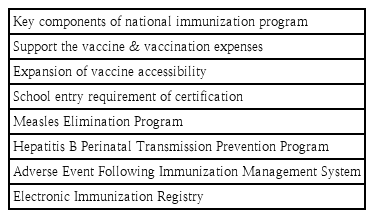
In the coronavirus disease 2019 (COVID-19) pandemic, children experience heightened barriers to health and protective services. Children may also be disproportionately affected due to their reliance on the education system for daily tasks and lack of access to remote learning options. Republic of Korea findings on how vaccination coverage could be sustained in children and schools could be reopened without aggravating COVID-19 underlie the need for coordinated efforts across sectors.
- Letter to the Editor
- Neonatology (Perinatology)
- Role of neutrophil CD11b expression in diagnosis of earlyonset neonatal sepsis in full-term infant
- Safaa ELMeneza, Walaa Mohamed, Iman Elbagoury, Karima Bahagat
- Clin Exp Pediatr. 2021;64(1):44-45. Published online April 14, 2020
-
Question: Can CD11b detect sepsis in full-term infants with suspected sepsis?
Finding: The percentage of neutrophils expressing CD11b was significantly upregulated in the sepsis and suspected sepsis groups versus the control group.
Meaning: CD11b is a sensitive marker for sepsis and suspected sepsis in full-term neonates and it may be added to sepsis markers. This information would allow the neonatologist to confidently discontinue antibiotic use as long as the neonate is clinically stable.
- Original Article
- Neonatology (Perinatology)
- The protective effect of CXC chemokine receptor 2 antagonist on experimental bronchopulmonary dysplasia induced by postnatal systemic inflammation
- Seung Hyun Lee, Chang Won Choi
- Clin Exp Pediatr. 2021;64(1):37-43. Published online July 15, 2020
-

Question: Can CXC chemokine receptor 2 (CXCR2) antagonist preserve alveolarization by attenuating the inflammation induced by systemic lipopolysaccharide (LPS) administration in a rat model of bronchopulmonary dysplasia (BPD)?
Finding: CXCR2 antagonist significantly decreased neutrophil counts in bronchoalveolar lavage fluid and peripheral blood induced by systemic LPS administration and restored alveolarization in newborn rats.
Meaning: CXCR2 antagonist protected the lungs from the inflammation in a rat model of BPD.
- Gastroenterology
- Noninvasive markers for esophageal varices in children with cirrhosis
- Parisa Rahmani, Fatemeh Farahmand, Ghobad Heidari, Azadeh Sayarifard
- Clin Exp Pediatr. 2021;64(1):31-36. Published online July 21, 2020
-
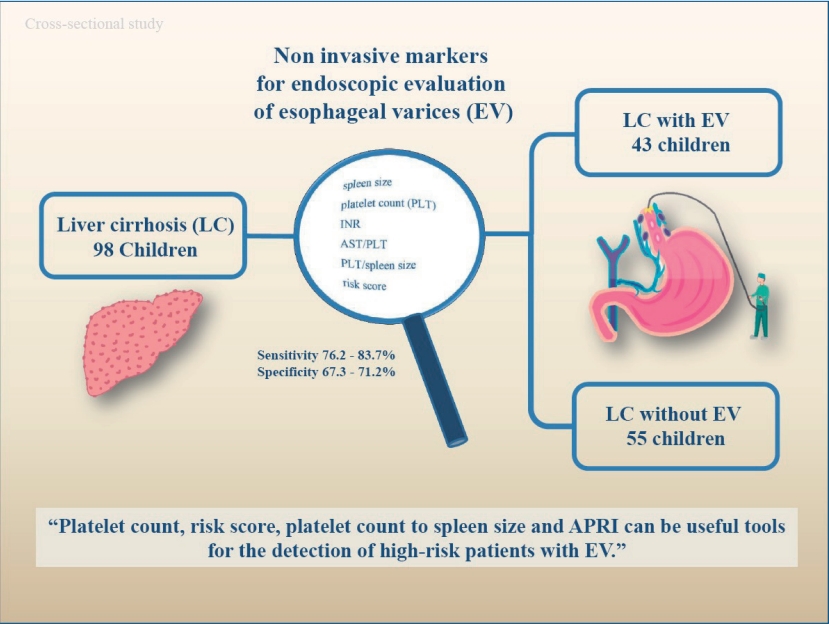
Question: Can noninvasive biomarkers identify esophageal varices among children with esophageal cirrhosis?
Finding: The spleen size, platelet count, international normalized ratio, aspartate aminotransferase to platelet ratio index, platelet count to spleen size ratio, and risk score differed significantly between the patients with and those without esophageal varices.
Meaning: These biological parameters can predict esophageal varices among pediatric patients and indicate the need for esophagogastroduodenoscopy.
- Editorial
- Neonatology (Perinatology)
- Neutrophil CD11b as a promising marker for early detection of neonatal sepsis
- Ju Sun Heo
- Clin Exp Pediatr. 2021;64(1):28-30. Published online September 1, 2020
-
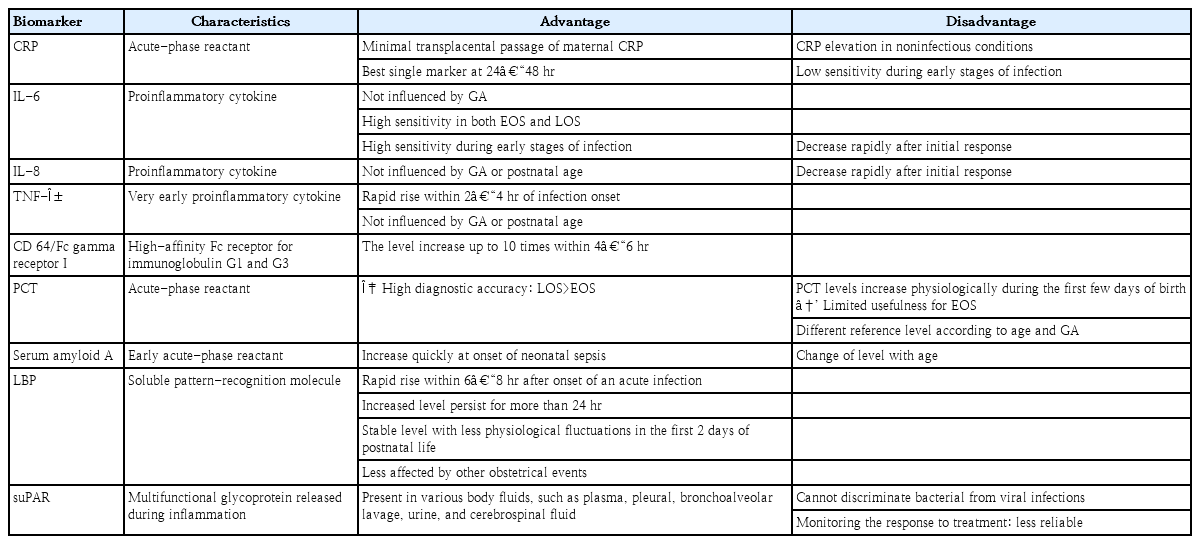
· Neonatal sepsis is a global problem and significant cause of neonatal mortality and adverse short- and long-term outcomes.
· Due to severe limitations diagnosing neonatal sepsis, there is a critical need to identify reliable specific biomarkers for early detection.
· nCD11b might be an accurate and rapid biomarker for the early detection of neonatal sepsis.
- General Pediatrics
- Why should we be concerned about early menarche?
- Hae Sang Lee
- Clin Exp Pediatr. 2021;64(1):26-27. Published online July 13, 2020
-
· Early menarche is associated with several health problems in later life.
· Early menarche can be caused by environmental factors such as increased subcutaneous fat, a high body mass index, and sugar-sweetened beverages as well as genetic factors.
· Health education can prevent early menarche by aiming to reduce the consumption of fructose, high concentrations of which are present in sugar-sweetened beverages.
- Review Article
- Gastroenterology
- Changing prevalence of Helicobacter pylori infection in children and adolescents
- Ji Sook Park, Jin Su Jun, Ji-Hyun Seo, Hee-Shang Youn, Kwang-Ho Rhee
- Clin Exp Pediatr. 2021;64(1):21-25. Published online July 15, 2020
-

Although Helicobacter pylori infection rate in children is unclear due to diversity and limitation of diagnostic tests unlike in adults, investigation the childhood prevalence is important for predicting H. pylori-related diseases in the future.
H. pylori infection occurred in early childhood, and declined during 30 years in our study.
Change in risk factors of H. pylori transmission and consensus for eradication therapy in children might further reduce the infection rate.
- Endocrinology
- Early menarche and its consequence in Korean female: reducing fructose intake could be one solution
- Ji Hyun Kim, Jung Sub Lim
- Clin Exp Pediatr. 2021;64(1):12-20. Published online May 14, 2020
-

In Korea, the average age of menarche has declined sharply. Early menarche is associated with psychosocial and behavioral problems and cardiometabolic disease. Excess fructose intake has been suggested as one cause of early menarche in recent studies, so reducing fructose intake may be one solution.
- Other
- Review of epidemiological studies on air pollution and health effects in children
- Jong-Tae Lee
- Clin Exp Pediatr. 2021;64(1):3-11. Published online June 10, 2020
-
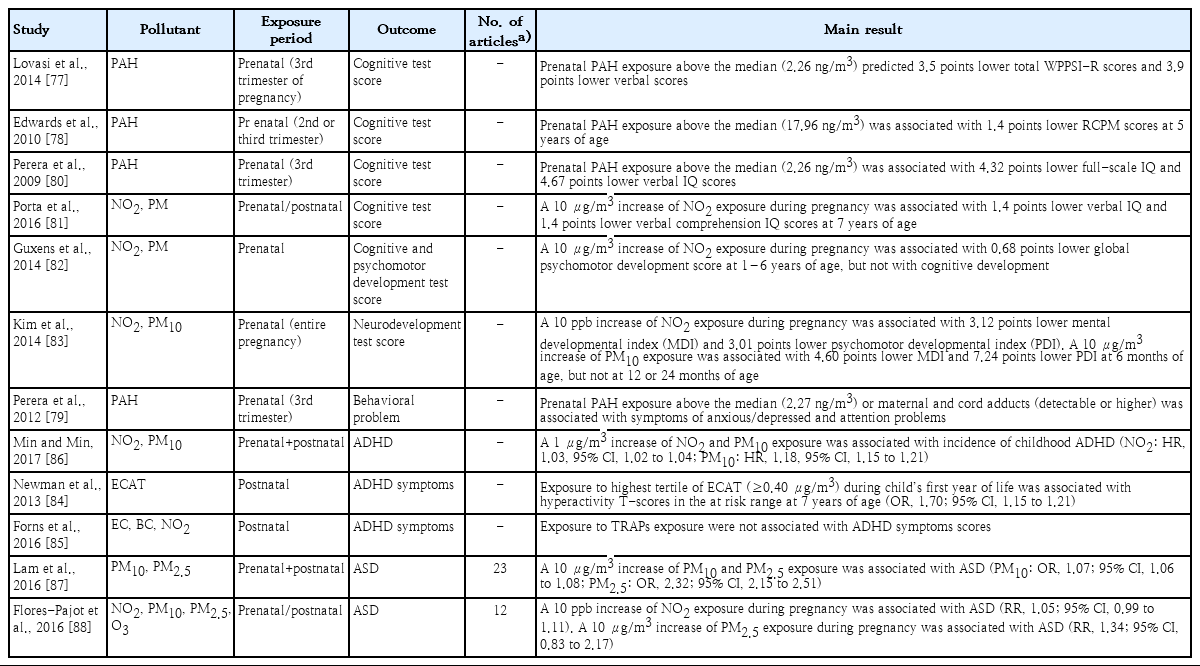
This review summarized the accumulated epidemiologic evidence with emphasis on studies conducted in Korea and heterogeneity in the literature. Based on systematic reviews and meta-analyses, there is consistent evidence on the association between exposure to ambient air pollution and children’s health, especially respiratory health and adverse birth outcomes, and growing evidence on neurodevelopmental outcomes.
- Perspective
- Neurology
- How can pediatricians treat neurodevelopmental disorders
- Young-Hoon Kim
- Clin Exp Pediatr. 2021;64(1):1-2. Published online July 27, 2020
-
∙ Recently neurodevelopmental therapy for preschool-aged children with neurodevelopmental disorders is paid for by health insurance in Korea.
∙ There are good evidences that parenting programs and neurodevelopmental therapy can work in attention deficit hyperactivity disorder and autism spectrum disorder.
∙ Pediatricians must be able to pass away important information to parents.
- Clinical note
- Infection
- Coronavirus disease 2019 in a 2-month-old male infant: a case report from Iran
- Hosein Heydari, Seyed Kamal Eshagh Hossaini, Ahmad Hormati, Mahboubeh Afifian, Sajjad Ahmadpour
- Clin Exp Pediatr. 2020;63(12):499-502. Published online September 21, 2020
-

-
DOI: https://doi.org/10.3345/cep.2020.00941 Retraction in: Clin Exp Pediatr 2022;65(8):417
- Original Article
- Nephrology (Genitourinary)
- Sonographic renal length and volume of normal Thai children versus their Chinese and Western counterparts
- Chantima Rongviriyapanich, Thanarat Sakunchit, Chirawat Sudla, Supamas Mungkung, Napapong Pongnapang, Chai Hong Yeong
- Clin Exp Pediatr. 2020;63(12):491-498. Published online July 13, 2020
-

Question: What is the normal renal size of Thai children and is the renal nomogram comparable to those of Western and Chinese cohorts?
Finding: The renal length of Thai children was moderately correlated with that of Western children, while the age-specific renal volume was significantly smaller than that of Chinese children.
Meaning: Renal size in children can vary among regions and sociodemographic backgrounds; hence, a local reference standard is needed.
- Gastroenterology
- Evaluating the effects of probiotics in pediatrics with recurrent abdominal pain
- Parisa Rahmani, Azin Ghouran-orimi, Farzaneh Motamed, Alireza Moradzadeh
- Clin Exp Pediatr. 2020;63(12):485-490. Published online July 21, 2020
-

Question: ecurrent abdominal pain (RAP) is a chief complaint among pediatrics and is associated with reduced quality of life, for both parent and child, and economic burden. Does probiotics reduce the frequency of RAP among children?
Finding: This study reported the effects of Lactobacillus reuteri probiotics among children with RAP as a result of multiple etiologies.
Meaning: The administration of probiotic supplements is significantly associated with pain relief among RAP children presented with functional abdominal pain, irritable bowel syndrome, and functional dyspepsia.
- Editorial
- Allergy
- Insights into pediatric pollen food allergy syndrome
- Jeong Hee Kim
- Clin Exp Pediatr. 2020;63(12):483-484. Published online June 1, 2020
-
- Review Article
- Infection
- The COVID-19 pandemic: an unprecedented tragedy in the battle against childhood obesity
- Maximilian Andreas Storz
- Clin Exp Pediatr. 2020;63(12):477-482. Published online November 5, 2020
-

Large-scale quarantine and home confinement during the coronavirus disease 2019 (COVID-19) pandemic will impose new and unfamiliar stressors on children, thereby worsening the childhood obesity epidemic. Physical, nutritional, and psychosocial factors that promote obesity in children during this special situation complementarily contribute to an unprecedented obesogenic environment. Involved stakeholders, including governments, schools, and families, must make all efforts to minimize the impact of the COVID-19 epidemic on childhood obesity.
- Pulmonology
- Current perspectives on atypical pneumonia in children
- Jung Yeon Shim
- Clin Exp Pediatr. 2020;63(12):469-476. Published online June 10, 2020
-
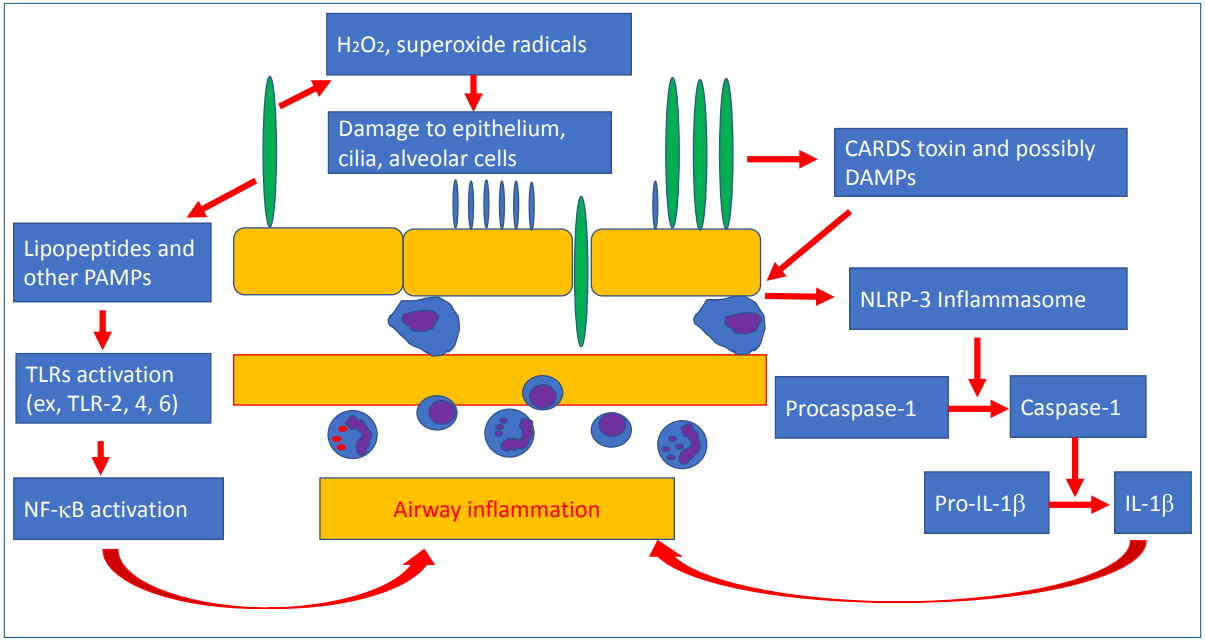
Macrolides are the first line treatment in atypical pneumonia caused by M. pneumoniae, C. pneumoniae, and L. pneumophila. Macrolide-resistant mycoplasma pneumonia (MRMP) is emerging worldwide, especially in East Asia. Immune modulators such as corticosteroids or second line antibiotics are treatment options for MRMP. Pediatricians should be careful with empirical therapy of macrolides in children with mild to moderate community-acquired pneumonia not to increase the risk of MRMP.
- Allergy
- Pollen-food allergy syndrome in children
- You Hoon Jeon
- Clin Exp Pediatr. 2020;63(12):463-468. Published online May 14, 2020
-

The prevalence of pollen-food allergy syndrome (PFAS) in Korean children with pollen allergy was recently reported to be 42.7%. PFAS can cause a wide range of symptoms from mild allergy to severe anaphylaxis depending on the nature of food allergens that share the epitopes with pollen. Cases of anaphylaxis caused by PFAS have recently increased. Treatments for PFAS should be individualized for patients according to the severity of symptoms.
- Guideline
- Endocrinology
- 2017 Clinical practice guidelines for dyslipidemia of Korean children and adolescents
- Jung Sub Lim, Eun Young Kim, Jae Hyun Kim, Jae-Ho Yoo, Kyung Hee Yi, Hyun Wook Chae, Jin-Ho Choi, Ji Young Kim, Il Tae Hwang; the Committee of Dyslipidemia of Korean Children and Adolescents on behalf of Korean Society of Pediatric Endocrinology (KSPE)
- Clin Exp Pediatr. 2020;63(12):454-462. Published online November 25, 2020
-
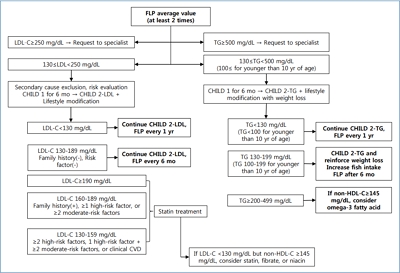
Question: How are children and adolescents with dyslipidemia treated and managed in Korea?
Finding: 2017 guidelines recommend to measure nonfasting non-HDL-C as a screening test and introduce new diet methods: Cardiovascular Health Integrated Lifestyle Diet (CHILD)-1, CHILD-2-low-density lipoprotein cholesterol, and CHILD-2-triglyceride. Statin is the only drug approved in children older than 10 years.
Meaning: New clinical practice guidelines for treating and managing dyslipidemia of Korean children and adolescents are provided.
- Clinical Note
- Allergy
- Recurrent urticaria caused by specific cat serum albumin IgE cross-reacting with pork serum albumin
- Cheon Kim, Sung Won Kim, Yoon Ha Hwang
- Clin Exp Pediatr. 2020;63(11):451-453. Published online April 6, 2020
-
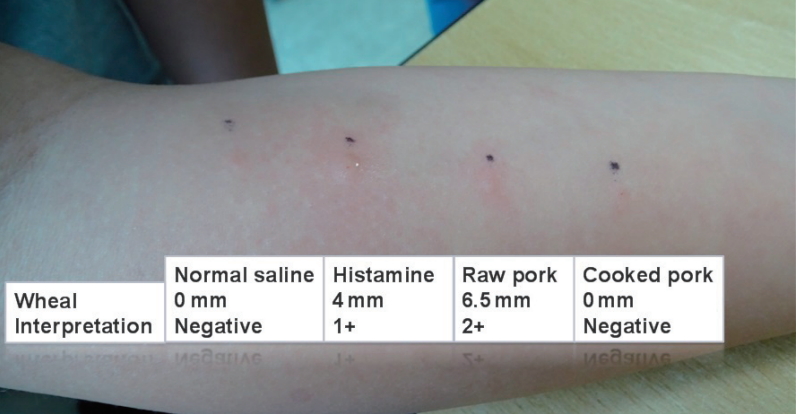
Question: What should be considered in children who complain of pork allergies?
Finding: History of raising a cat, the onset of symptoms after the ingestion of pork and specific IgE tests to pork, cat, milk, and Alpha-gal are needed.
Meaning: Pork cat syndrome could be the cause of pork allergies.
- Original Article
- Gastroenterology
- Acquired noncaustic esophageal strictures in children
- Elif Sag, Aysenur Bahadir, Mustafa Imamoglu, Sefa Sag, Gokce Pinar Reis, Erol Erduran, Murat Cakir
- Clin Exp Pediatr. 2020;63(11):447-450. Published online October 15, 2020
-
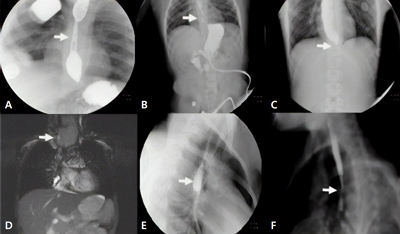
Question: Which clinical findings suggest esophageal structure in children with dysphagia?
Finding: The presence of solid dysphagia, malnutrition, and a comorbid condition is suggestive of esophageal stricture in children with dysphagia.
Meaning: Patients with findings suggestive of noncaustic esophageal stricture should receive early referral to pediatric gastroenterology units.
- Developmental and Behavioral Medicine
- Development of the Korean Developmental Screening Test for Infants and Children (K-DST)
- Hee Jung Chung, Donghwa Yang, Gun-Ha Kim, Sung Koo Kim, Seoung Woo Kim, Young Key Kim, Young Ah Kim, Joon Sik Kim, Jin Kyung Kim, Cheongtag Kim, In-Kyung Sung, Son Moon Shin, Kyung Ja Oh, Hee-Jeong Yoo, Hee Joon Yu, Seoung-Joon Lim, Jeehun Lee, Hae-Ik Jeong, Jieun Choi, Jeong-Yi Kwon, Baik-Lin Eun
- Clin Exp Pediatr. 2020;63(11):438-446. Published online May 14, 2020
-

Question: Can the Korean Developmental Screening Test for Infants and Children (K-DST) be a useful screening tool for infants and children in Korea?
Finding: The K-DST has high reliability (internal consistency of 0.73–0.93, test-retest reliability of 0.77–0.88) and a high discriminatory ability with a sensitivity of 0.833 and specificity of 0.979.
Meaning: The K-DST is an effective and reliable screening tool for infants and children with neurodevelopmental disorders in Korea.
- Neonatology (Perinatology)
- Knowledge and perceptions of kangaroo mother care among health providers: a qualitative study
- Hadi Pratomo, Tiara Amelia, Fatmawati Nurlin, Asri C. Adisasmita
- Clin Exp Pediatr. 2020;63(11):433-437. Published online July 21, 2020
-

Question: What are health providers’ knowledge and perceptions of Kangaroo mother care (KMC)?
Finding: Health providers’ knowledge of KMC was sufficient; however, some of their perceptions about it could create barriers to the successful implementation of hospital KMC programs.
Meaning: Health providers’ perceptions about KMC should be considered to ensure successful KMC implementation. Locally designed on-site training programs could overcome the challenges.
-

-
-
8.02023CiteScore94th percentilePowered by
-
Impact Factor3.2
-
- TOPICS
- ARTICLE CATEGORY
- Editorial Office
-
Korean Pediatric Society
#1606 Seocho World Officetel, 19 Seoun-ro, Seocho-ku, Seoul 06732, Korea
Tel: +82-2-3473-7306 Fax: +82-2-3473-7307 E-mail: office@e-cep.org
Clinical and Experimental Pediatrics is an open access journal. All articles are distributed under the terms of the Creative Commons Attribution NonCommercial License (http://creativecommons.org/licenses/by-nc/4.0/)
Copyright © 2025 by Korean Pediatric Society.











